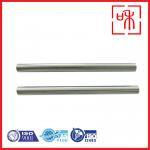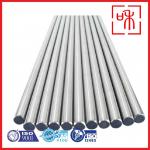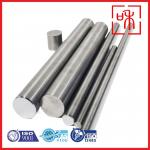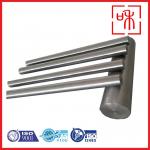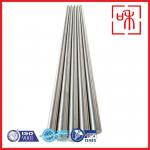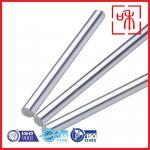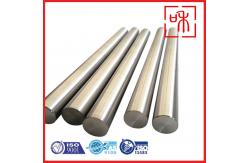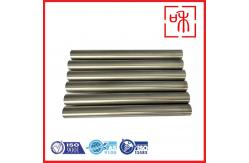Introduction
Medical titanium bars, particularly those manufactured in ASTM
Grade 5, represent a significant advancement in the field of
medical materials. This grade, also known as Ti-6Al-4V, is an alloy
composed of 90% titanium, 6% aluminum, and 4% vanadium, making it
one of the most commonly used titanium alloys in medical
applications. Its exceptional properties make it an ideal choice
for manufacturing a wide range of medical devices, prostheses,
artificial organs, and auxiliary treatment devices that are
implanted in the human body.
One of the key advantages of ASTM Grade 5 titanium alloys is their
high specific strength. This characteristic allows for the creation
of implants that are not only lightweight but also strong enough to
withstand the stresses encountered in the human body. The
mechanical properties of these alloys closely mimic those of human
bone, which is crucial for ensuring the proper integration and
functionality of implants. This similarity helps in reducing the
risk of complications such as stress shielding, where the
difference in stiffness between the implant and surrounding bone
can lead to bone resorption and implant failure.
In addition to their mechanical advantages, ASTM Grade 5 titanium
alloys exhibit excellent fatigue resistance. This property is vital
for devices that will experience repeated loading and unloading,
such as joint replacements and dental implants. The fatigue
resistance of titanium ensures that these devices maintain their
integrity over time, even under strenuous conditions.
Corrosion resistance is another remarkable feature of titanium
alloys. The human body is a complex environment filled with various
fluids and biological substances that can cause the degradation of
materials. However, titanium forms a protective oxide layer that
significantly enhances its resistance to corrosion. This
characteristic is particularly important for implants that must
remain in the body for extended periods, as it helps ensure
long-term durability and reliability.
Furthermore, the biocompatibility of ASTM Grade 5 titanium alloys
is a crucial factor in their use in medical applications. These
alloys do not induce adverse reactions when in contact with human
tissue, making them safe for implantation. This biocompatibility is
supported by extensive research and clinical studies, confirming
that titanium implants integrate well with bone and other tissues.
In our inventory, we maintain a variety of medical titanium bars in
different sizes and specifications, ensuring that we can meet the
diverse needs of our clients in the medical industry. Our advanced
manufacturing processes adhere to stringent quality standards,
allowing us to produce titanium bars that not only meet but exceed
industry requirements.
In conclusion, ASTM Grade 5 medical titanium bars are indispensable
in the production of high-quality medical devices. Their unique
combination of strength, fatigue resistance, corrosion resistance,
and biocompatibility positions them as a superior choice for
implants and other medical applications. As the demand for
innovative and reliable medical solutions continues to grow, the
role of titanium alloys will remain central to advancements in
patient care and surgical technology.
Gr 5 titanium alloy bar / rod Chemical Composition
| Grade | Ti | C | Fe | H | N | O | Al | V |
| Ti Grade5 | 90 min | – | 0.25 max | – | – | 0.2 max | 6 min | 4 min |
Gr 5 titanium bar / rod Mechanical Properties
| Element | Density | Melting Point | Tensile Strength | Yield Strength (0.2%Offset) | Elongation |
| Titanium Gr. 5 | 4.43 g/cm3 | 1632 °C (2970 °F) | Psi – 138000 , MPa – 950 | Psi – 128000 ,
MPa – 880 | 14 % |
Equivalent Grades for Gr 5
| STANDARD | WERKSTOFF NR. | UNS |
| Titanium Gr. 5 | 3.7165 | N56400
|
Advantages of Titanium Rods
Titanium rods offer numerous advantages over traditional materials
like steel and aluminum. Here are some key benefits:
Biocompatibility: One of titanium's standout properties is its biocompatibility. It
is non-toxic and does not induce adverse reactions in the human
body, making it a preferred material for medical implants, dental
devices, and prosthetics. Its use in healthcare continues to
expand, driven by its safety and effectiveness.
Non-magnetic: Titanium is inherently non-magnetic, making it an ideal choice for
applications in medical equipment, such as MRI machines, where
magnetic interference could disrupt functionality. This property is
crucial in ensuring the safety and accuracy of medical imaging.
Strength: Titanium boasts a very high strength-to-weight ratio, meaning it
is stronger than steel while remaining significantly lighter. This
property is particularly beneficial in applications where reducing
weight is critical, such as in aerospace and automotive industries.
Corrosion Resistance: The natural oxide layer on titanium provides exceptional
resistance to corrosion. This feature enables titanium to perform
reliably in harsh environments, including marine and chemical
applications, where other materials might degrade quickly.
Durability: Titanium is highly resistant to wear and tear, significantly
outlasting many other materials. This durability translates to
lower maintenance costs and longer service life in various
applications, from industrial machinery to consumer goods.
Aesthetics: Titanium has a unique and attractive appearance that makes it
popular in jewelry and decorative applications. Its lustrous finish
and ability to take on vibrant colors through anodization have made
titanium a fashionable choice for high-end accessories.
Technical Parameters:
| Name | Material | Shape | Surface | Standards | Grade |
|---|
| Titanium Bar / Titanium Rod | Titanium Metal Or Alloy | Square, round, Hexagonal | Polished, Sandblasted, Anodized, black, picking Sand-blasting | ASTM B348, ASME SB348, ASTM F67, ASTM F136, AMS4928, AMS2631b | Gr1, Gr2, 3, 4, 5, 9, 12 |
Applications:
Orthopedic implants include artificial joints, metal plates,
orthopedic nails, metal orthopedic use rods, intramedullary nails,
bone needles, and spinal fixation devices.
Heart medicine implants are also available, such as artificial
heart valves, cardiac pacemakers, cardiac catheters and stents
within blood vessels.
Ophthalmic implants consist of artificial crystals while dental
implants include dental implants, traction nails, nail plant root
canal, and internal fixation devices, among others.
Moreover, there are also available filling materials for breast
filling, intraocular filling materials, and filling materials in
orthopedics.
